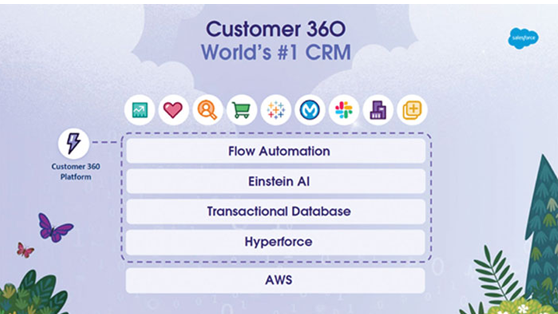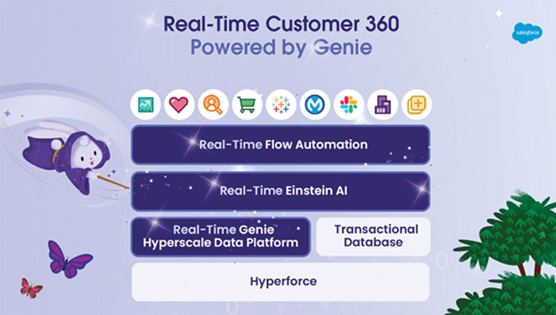As discussed earlier, Salesforce Data Cloud brings together the real-time customer 360 vision for Salesforce (Figure 3.19).

Figure 3.19: Salesforce 360 vision
Powered by AWS, the Salesforce Customer 360 platform provided the hyper-scale platform Hyperforce, on top of which we had the transactional database which stored our Salesforce data. Einstein AI provided descriptive and predictive analytics, and flow automation enabled businesses to automate certain business processes. The different Salesforce applications run like Sales Cloud, Service Cloud, Salesforce Industries, and so on ran on this customer 360 platform.
But with the onset of Data Cloud, the platform changed, as depicted in Figure 3.20:

Figure 3.20: Data Cloud powers real-time Customer 360
It is still powered by AWS and the Hyperforce platform. But in addition to the transnational database, we also have the real-time Data Cloud hyper-scale data platform for storing our customer data. With the combination of the data in the customer data platform and the transactional database, we have more visibility on the customers. The Einstein AI platform has now become the real-time Einstein AI platform that provides descriptive and predictive analysis of real-time data. Data Cloud has transformed flow automation into real-time flow automation. Therefore, all the Salesforce applications are now powered by real-time data from Data Cloud.
Salesforce Data Cloud was introduced to help businesses bring data from different systems in real-time and store in a consolidated place and enable user profile creation. It’s real-time data capabilities solved several challenges faced by CDP tools. The unique user profiles help businesses to deliver superior customer experiences.
In the next chapter, we will talk in more detail about Salesforce Data Cloud architecture. We are going to study in detail the key building blocks of Salesforce Data Cloud and understand how they interact with each other. We will also talk about the benefits of Salesforce Data Cloud and learn how to drive productivity, efficiency, and value with Salesforce Data Cloud.
